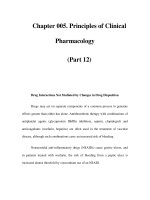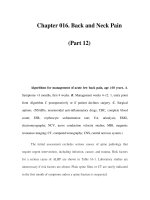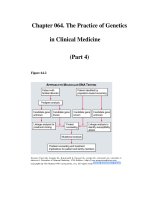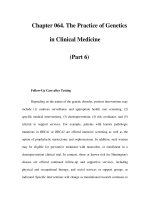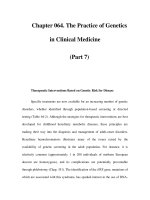Chapter 124. Sexually Transmitted Infections: Overview and Clinical Approach (Part 12) Figure ppt
Bạn đang xem bản rút gọn của tài liệu. Xem và tải ngay bản đầy đủ của tài liệu tại đây (37.42 KB, 5 trang )
Chapter 124. Sexually Transmitted Infections:
Overview and Clinical Approach
(Part 12)
Figure 124-5
Gram's stain of cervical mucus, showing a strand of cervica
l mucus
containing many polymorphonuclear leukocytes. This picture is typical of
mucopurulent cervicitis. Note that leukocytes are not seen in areas of the slide
containing vaginal epithelial cells, adjacent to the mucus strands.
Mucopurulent Cervicitis: Treatment
Although the above criteria for MPC are neither highly specific nor highly
predictive of gonococcal or chlamydial infection in some settings, the 2006 CDC
guidelines call for consideration of empirical treatment for MPC, pending test
results, in certain patients. Treatment with antibiotics active against C. trachomatis
should be provided for women at increased risk for this common STI (risk factors:
age <25 years, new or multiple sex partners, and unprotected sex), especially if
follow-up connot be ensured and if a relatively insensitive diagnostic test (not a
NAAT) is used. Concurrent therapy for gonorrhea is indicated if the prevalence of
this infection is high (>5%) in the relevant patient population (e.g., young adults, a
clinic with documented high prevalence). In this situation, therapy should include
a single-dose regimen effective for gonorrhea plus treatment for chlamydial
infection, as outlined in Table 124-4 for the treatment of urethritis. In settings
where gonorrhea is much less common than chlamydial infection, initial therapy
for chlamydial infection alone suffices, pending test results for gonorrhea. The
etiology and potential benefit of treatment for endocervicitis not associated with
gonorrhea or chlamydial infection have not been established. Although the
antimicrobial susceptibility of M. genitalium is not yet well defined, the organism
frequently persists after doxycycline therapy, and it currently seems reasonable to
use azithromycin to treat possible M. genitalium infection in such cases. The
sexual partner(s) of a woman with MPC should be examined and given a regimen
similar to that chosen for the woman unless results of tests for gonorrhea or
chlamydial infection in either partner warrant different therapy or no therapy.
Cervical Ectopy
Cervical ectopy, often mislabeled "cervical erosion," is easily confused
with infectious endocervicitis. Ectopy represents the presence of the one-cell-thick
columnar epithelium extending from the endocervix out onto the visible
ectocervix. In ectopy, the cervical os may contain clear or slightly cloudy mucus
but usually not yellow mucopus. Colposcopy shows intact epithelium. Normally
found during adolescence and early adulthood, ectopy gradually recedes through
the second and third decades of life, as squamous metaplasia replaces the ectopic
columnar epithelium. Oral contraceptive use favors the persistence or
reappearance of ectopy, while smoking apparently accelerates squamous
metaplasia. Cauterization of ectopy is not warranted. Ectopy may render the cervix
more susceptible to infection with N. gonorrhoeae, C. trachomatis, or HIV.
Pelvic Inflammatory Disease
The term pelvic inflammatory disease usually refers to infection that
ascends from the cervix or vagina to involve the endometrium and/or fallopian
tubes. Infection can extend beyond the reproductive tract to cause pelvic
peritonitis, generalized peritonitis, perihepatitis, perisplenitis, or pelvic abscess.
Rarely in young women, infection not related to STI extends secondarily to the
pelvic organs (1) from adjacent foci of inflammation (e.g., appendicitis, regional
ileitis, or diverticulitis), (2) as a result of hematogenous dissemination (e.g., of
tuberculosis), or (3) as a complication of certain tropical diseases (e.g.,
schistosomiasis). Intrauterine infection can be primary (spontaneously occurring
and usually sexually transmitted) or secondary to invasive intrauterine surgical
procedures [e.g., dilatation and curettage, termination of pregnancy, insertion of an
intrauterine device (IUD), or hysterosalpingography] or to parturition.
Etiology
The agents most often implicated in acute PID include the primary causes
of endocervicitis (e.g., N. gonorrhoeae and C. trachomatis) and organisms that can
be regarded as components of an altered vaginal flora. In general, PID is most
often caused by N. gonorrhoeae where there is a high incidence of gonorrhea—
e.g., in developing countries and in indigent inner-city populations in the United
States. In recent case-control studies, M. genitalium has also been significantly
associated with histopathologic diagnoses of endometritis and with salpingitis.
Anaerobic and facultative organisms (especially Prevotella species,
peptostreptococci, E. coli, Haemophilus influenzae, and group B streptococci) as
well as genital mycoplasmas have been isolated from the peritoneal fluid or
fallopian tubes in a varying proportion (typically one-fourth to one-third) of
women with PID studied in the United States. The difficulty of determining the
exact microbial etiology of an individual case of PID—short of using invasive
procedures for specimen collection—has implications for the approach to
empirical antimicrobial treatment of this infection.

